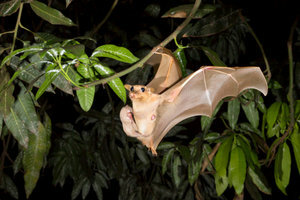Spore bone in the bat
Besides the fruit bats, bats are the only mammals that can fly. Both groups form the order of the bats (Chiroptera). The bat's body has optimally adapted to this type of movement. This is proven not only by the large flight membranes, but also by special features of the skeleton, such as the spur bone.

The nocturnal sailors are perfectly adapted to their way of life. You are probably familiar with the bat's sense of direction via echolocation. She owes her flying skills to the flight skin. Bats spread these like wings between the extremes. The spur bone is also used here.
Bat's way of life
- The flight acrobats are mostly active at dusk or at night. Many species feed on insects, making them very useful animals. Larger species also prey on small mammals and even other bats. Some species, especially in the tropics, also look for flowers to drink nectar or eat fruit. They are the vegetarians among the animals. The vampire bats are the ones you know as blood-sucking creatures of the night from horror movies. There are only three species that feed exclusively on the blood of other living things.
- Typical of bats is their ability to fly. You can often see the animals at dusk, but then you can mostly only see the outlines of the sailors. If the animals have narrow wings, they fly quickly; if the wings are rather wide, the flight is correspondingly slow. The animals spend the day hanging upside down from the ceiling in caves or under the roofs of old buildings, some in tree hollows.
- Some species take their prey in flight. So they are nimble beings of the air. As with birds, the entire body is subordinate to the ability to fly. Long and especially light bones of the extremities are a prerequisite for a bat to glide effortlessly through the air. The spore bone plays a special role in this.
The function of the spore bone
- Bats do not have feathers and no wings. What you can visually compare well with the wing of a bird is a flight membrane that is stretched out to fly. This membrane consists of two layers of skin that are strengthened by muscles and traversed by nerve fibers and blood vessels.
- The flight membrane is very elastic. It extends from the limbs in front to those in the back and also to the tail. All finger bones are very tender and long in order to stretch the flight membrane. The thumb has a claw. On the heel of the hind legs, bats have a spur, also called a spur leg. It is used to stretch and support the tail skin.
- The spore bone is a cartilaginous process that mainly spans the flight membrane of the tail. In the noctule bat, however, the spore bone also has a stiff piece of skin in the tail membrane.
- The spur of the bats is an example of how the physique changes over the course of the year evolution adapts to the way of life of animals. As flying mammals, they have conquered a habitat that was otherwise only reserved for birds. They can maneuver quickly with the help of the tail membrane. Without the spur bone, the control of the flight would be very limited.
Bat - thumb and other special features in 3 pictures
After rodents, they are the most species-rich order among mammals - the ...
How helpful do you find this article?

